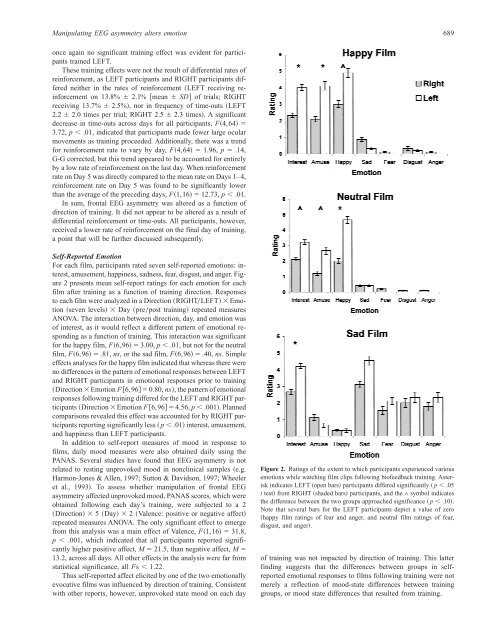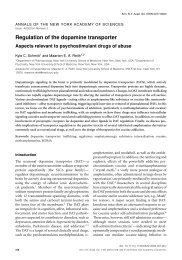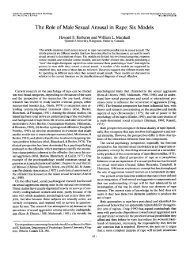Manipulation of frontal EEG asymmetry through biofeedback alters ...
Manipulation of frontal EEG asymmetry through biofeedback alters ...
Manipulation of frontal EEG asymmetry through biofeedback alters ...
Create successful ePaper yourself
Turn your PDF publications into a flip-book with our unique Google optimized e-Paper software.
Manipulating <strong>EEG</strong> <strong>asymmetry</strong> <strong>alters</strong> emotion 689<br />
once again no significant training effect was evident for participants<br />
trained LEFT.<br />
These training effects were not the result <strong>of</strong> differential rates <strong>of</strong><br />
reinforcement, as LEFT participants and RIGHT participants differed<br />
neither in the rates <strong>of</strong> reinforcement ~LEFT receiving reinforcement<br />
on 13.8% 6 2.1% @mean 6 SD# <strong>of</strong> trials; RIGHT<br />
receiving 13.7% 6 2.5%!, nor in frequency <strong>of</strong> time-outs ~LEFT<br />
2.2 6 2.0 times per trial; RIGHT 2.5 6 2.3 times!. A significant<br />
decrease in time-outs across days for all participants, F~4,64! <br />
3.72, p .01, indicated that participants made fewer large ocular<br />
movements as training proceeded. Additionally, there was a trend<br />
for reinforcement rate to vary by day, F~4,64! 1.96, p .14,<br />
G-G corrected, but this trend appeared to be accounted for entirely<br />
by a low rate <strong>of</strong> reinforcement on the last day. When reinforcement<br />
rate on Day 5 was directly compared to the mean rate on Days 1–4,<br />
reinforcement rate on Day 5 was found to be significantly lower<br />
than the average <strong>of</strong> the preceding days, F~1,16! 12.73, p .01.<br />
In sum, <strong>frontal</strong> <strong>EEG</strong> <strong>asymmetry</strong> was altered as a function <strong>of</strong><br />
direction <strong>of</strong> training. It did not appear to be altered as a result <strong>of</strong><br />
differential reinforcement or time-outs. All participants, however,<br />
received a lower rate <strong>of</strong> reinforcement on the final day <strong>of</strong> training,<br />
a point that will be further discussed subsequently.<br />
Self-Reported Emotion<br />
For each film, participants rated seven self-reported emotions: interest,<br />
amusement, happiness, sadness, fear, disgust, and anger. Figure<br />
2 presents mean self-report ratings for each emotion for each<br />
film after training as a function <strong>of</strong> training direction. Responses<br />
to each film were analyzed in a Direction ~RIGHT0LEFT! Emotion<br />
~seven levels! Day ~pre0post training! repeated measures<br />
ANOVA. The interaction between direction, day, and emotion was<br />
<strong>of</strong> interest, as it would reflect a different pattern <strong>of</strong> emotional responding<br />
as a function <strong>of</strong> training. This interaction was significant<br />
for the happy film, F~6,96! 3.00, p .01, but not for the neutral<br />
film, F~6,96! .81, ns, or the sad film, F~6,96! .40, ns. Simple<br />
effects analyses for the happy film indicated that whereas there were<br />
no differences in the pattern <strong>of</strong> emotional responses between LEFT<br />
and RIGHT participants in emotional responses prior to training<br />
~Direction Emotion F @6,96# 0.80, ns!, the pattern <strong>of</strong> emotional<br />
responses following training differed for the LEFT and RIGHT participants<br />
~Direction Emotion F @6,96# 4.56, p .001!. Planned<br />
comparisons revealed this effect was accounted for by RIGHT participants<br />
reporting significantly less ~ p .01! interest, amusement,<br />
and happiness than LEFT participants.<br />
In addition to self-report measures <strong>of</strong> mood in response to<br />
films, daily mood measures were also obtained daily using the<br />
PANAS. Several studies have found that <strong>EEG</strong> <strong>asymmetry</strong> is not<br />
related to resting unprovoked mood in nonclinical samples ~e.g.<br />
Harmon-Jones & Allen, 1997; Sutton & Davidson, 1997; Wheeler<br />
et al., 1993!. To assess whether manipulation <strong>of</strong> <strong>frontal</strong> <strong>EEG</strong><br />
<strong>asymmetry</strong> affected unprovoked mood, PANAS scores, which were<br />
obtained following each day’s training, were subjected to a 2<br />
~Direction! 5 ~Day! 2 ~Valence: positive or negative affect!<br />
repeated measures ANOVA. The only significant effect to emerge<br />
from this analysis was a main effect <strong>of</strong> Valence, F~1,16! 31.8,<br />
p .001, which indicated that all participants reported significantly<br />
higher positive affect, M 21.5, than negative affect, M <br />
13.2, across all days. All other effects in the analysis were far from<br />
statistical significance, all Fs 1.22.<br />
Thus self-reported affect elicited by one <strong>of</strong> the two emotionally<br />
evocative films was influenced by direction <strong>of</strong> training. Consistent<br />
with other reports, however, unprovoked state mood on each day<br />
Figure 2. Ratings <strong>of</strong> the extent to which participants experienced various<br />
emotions while watching film clips following bi<strong>of</strong>eedback training. Asterisk<br />
indicates LEFT ~open bars! participants differed significantly ~ p .05<br />
t test! from RIGHT ~shaded bars! participants, and the ∧ symbol indicates<br />
the difference between the two groups approached significance ~ p .10!.<br />
Note that several bars for the LEFT participants depict a value <strong>of</strong> zero<br />
~happy film ratings <strong>of</strong> fear and anger, and neutral film ratings <strong>of</strong> fear,<br />
disgust, and anger!.<br />
<strong>of</strong> training was not impacted by direction <strong>of</strong> training. This latter<br />
finding suggests that the differences between groups in selfreported<br />
emotional responses to films following training were not<br />
merely a reflection <strong>of</strong> mood-state differences between training<br />
groups, or mood state differences that resulted from training.










